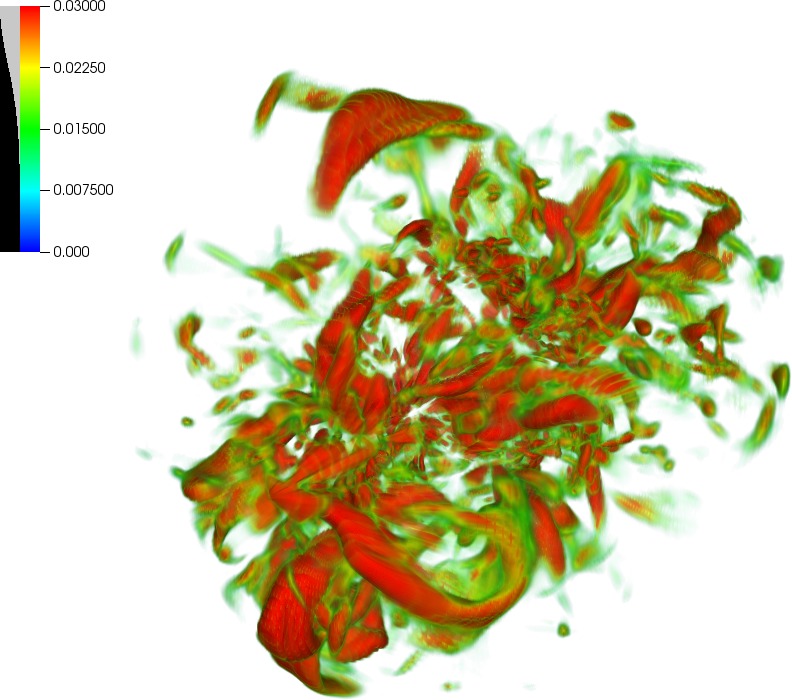3D Simulations of Core-Collapse Supernovae and their Progenitors
We performed 3D simulations of convective burning burning in massive stars and the subsequent supernova explosion. The supernova simulations are computed using an efficient solver for neutrino transport and evolved sufficiently far to study compute explosion and compact remnant properties. We studied supernova progenitor stars between 10 and 80 solar masses to analyse the distribution of neutron star and black hole birth masses, velocities and spin periods. We also used our simulation to predict the gravitational wave signals from supernova explosions.
Area of science
Astronomy
Systems used
Magnus
Applications used
CoCoNuT supernova codeThe Challenge
The explosion mechanism of massive stars is a long-standing puzzle in astrophysics. The most promising scenario for supernova explosions was already proposed decades ago: The young neutron star emits neutrinos, and a fraction of these are absorbed behind the supernova shock wave. If the energy thus deposited is sufficiently high, the shock will propagate through the entire envelope and expel it in its wake. Multi-dimensional fluid flow – for example in the form of convection – is essential in this mechanism as it transports neutrino-heated matter outwards and provides an effective “turbulent pressure” against the shock. A few successful 3D supernova explosion models have recently become available, but there are as yet too few models to understand the systematics of supernova explosion properties and the birth properties of the black holes and neutron stars made by these explosions.
The Solution
The key to understanding the systematics of supernova explosion properties and the distribution of neutron star and black hole birth masses, kicks, and spins lies in calculating a larger number of long-time simulations to better sample the supernova progenitor distribution.
The Outcome
In this project, we performed targeted supernova simulations for a sizable number of low-mass and high-mass stars. Our simulations point to a correlation between the progenitor mass, the explosion energy, and the birth velocity and spin rate of the neutron stars in successful supernova explosions. Thanks to the growing number of models, we are now able to explain a broader range of supernova explosion energies that is more compatible with the energies of observed supernovae. Our models also reproduce the observed range of neutron star spin periods and kicks. In simulations of black hole formation in fallback supernovae, we demonstrated that neutrino-driven explosions can also form quite rapidly spinning black holes with kicks of several 500 km/s.
List of Publications
Müller, Bernhard, Tauris, Thomas M., Heger, Alexander, Banerjee, Projjwal, Qian, Yong-Zhong, Powell, Jade, Chan, Conrad, Gay, Daniel W., & Langer, Norbert 2019, Monthly Notices of the Royal Astronomical Society 484, 3307
Powell, Jade & Müller, Bernhard 2019, Monthly Notices of the Royal Astronomical Society 487, 1178
Müller, Bernhard 2019, Monthly Notices of the Royal Astronomical Society 487, 5304
Müller, Bernhard & Chan, Conrad 2019, The Astrophysical Journal 870, 43
Yadav, Naveen, Müller, Bernhard, Janka, Hans Thomas, Melson, Tobias, & Heger, Alexander 2020, The Astrophysical Journal 890, 94
Moriya, Takashi J., Müller, Bernhard, Chan, Conrad, Heger, Alexander, & Blinnikov, Sergei I. 2019, The Astrophysical Journal 880, 21
Müller, B. 2019, Annual Review of Nuclear and Particle Science 69, 253
Powell, Jade & Müller, Bernhard 2020, arXiv e-prints arXiv:2002.10115, accepted for publication in Monthly Notices of the Royal Astronomical Society







